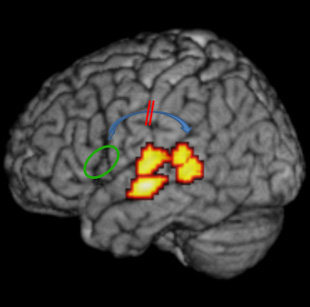Dyslexia is down to a connectivity problem between different parts of the brain that decode language, scientists in Belgium have  shown.
shown.
Dyslexia is not a new disorder. In fact, the first case was documented in the UK in 1896 by Pringle Morgan, who described in the British Medical Journal a "case of congenital word blindess." Now doctors and scientists estimate that up to one in ten people might be affected.
The condition is most visibly manifest as difficulty with reading, but dyslexic individuals also have problems with comprehension of information presented verbally too. So neuroscientists think that, when we read something, we first convert the written word into the equivalent spoken sounds in our heads, before decoding them as if what we had been reading had instead just been said to us.
It wasn't clear whether the problem in dyslexia is that the brain fails to form accurate neurological representations of sounds, or whether the interpretation of those sounds is the issue.
To find out, Leuven University researcher Bart Boets and his colleagues, writing in Science, used a functional MRI (fMRI) scanning technique to compare the neurological signatures created by the brains of 23 dyslexics with 22 non-dyslexics when they listened to a series of nonsense words spoken by 4 different individuals.
A series of different brain regions lit up in response to the stimuli, showing that they were involved in decoding the sounds, but there were no differences in the integrity of those neurological signatures between the brain areas in both the normal and dyslexic participants.
"This told us that there was no evidence that dyslexic people make poorer neurological representations of presented sounds," says study co-author Hans Op de Beeck.
If the brain is accurately mapping out presented sounds in various brain areas, then could the problem in dyslexia instead be that the ability of those different brain areas to exchange information amongst themselves through nerve connections is impaired in some way?
To find out, the team then reanalysed their data looking at the connectivity between the different brain areas. This can be done by looking at how tightly activity in one brain area mirrors activity in another area when stimuli are presented.
This revealed a significant deficit in a part of the brain's wiring loom called the arcuate fasciculus, which carries connections between a range of brain areas involved in speech and language functions.
"There was significantly reduced white matter integrity of the left arcuate fasciculus in dyslexics," says Op de Beeck. "This result provides neuroanatomical evidence that corroborates the deficiency in functional connectivity."
Intriguingly, the team found that their connectivity measures could account for over a third of the variance in reading and spelling abilities in their subjects, and they predicted dyslexia with an accuracy of 73%.
A reduction in brain connectivity, the team say, "impedes efficient access to otherwise intact representations of speech sounds, hampering a person's ability to manipulate them fluently."










Comments
Add a comment